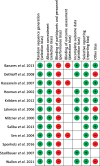Safety and efficacy of Single-Pass Albumin Dialysis (SPAD), Prometheus, and Molecular Adsorbent Recycling System (MARS) liver haemodialysis vs. Standard Medical Therapy (SMT): meta-analysis and systematic review
- PMID: 38939063
- PMCID: PMC11200067
- DOI: 10.5114/pg.2024.139297
Safety and efficacy of Single-Pass Albumin Dialysis (SPAD), Prometheus, and Molecular Adsorbent Recycling System (MARS) liver haemodialysis vs. Standard Medical Therapy (SMT): meta-analysis and systematic review
Abstract
Introduction: Because not all liver dysfunction patients are suitable for transplantations and there is a shortage of grafts, liver support therapies have gained interest. In this regard, extracorporeal albumin dialysis devices such as single-pass albumin dialysis (SPAD), Prometheus, and molecular adsorbent recycling system (MARS) have been valuable in supplementing standard medical therapy (SMT). However, the efficacy and safety of these devices is often questioned.Aim: We performed a systematic review to summarize the efficacy and safety of MARS, SPAD, and Prometheus as supportive treatments for liver dysfunction.
Material and methods: PubMed, Medline, Cochrane Library, Web of Science, and Google Scholar electronic databases were extensively searched for all randomized trials published in English. In addition, meta-analytic analyses were performed with Review Manager software, and Cochrane's risk of bias tool embedded in this software was used for bias assessment.
Results: Twelve trials including a total of 653 patients were eligible for inclusion. Subgroup analyses of data from these trials revealed that MARS and Prometheus were associated with significant removal of bilirubin (MD = -5.14 mg/dl; 95% CI: -7.26 - -3.02; p < 0.00001 and MD = -8.11 mg/dl; 95% CI: -12.40 - -3.82; p = 0.0002, respectively) but not bile acids and ammonia when compared to SMT. Furthermore, MARS was as effective as Prometheus and SPAD in the reduction of bilirubin (MD = 2.98 mg/dl; 95% CI: -4.26 - 10.22; p = 0.42 and MD = 0.67 mg/dl; 95% CI: -2.22 - 3.56; p = 0.65), bile acids (MD = -17.06 µmol/l; 95% CI: -64.33 - 30.20; p = 0.48 and MD = 16.21 µmol/l; 95% CI: -17.26 - 49.68; p = 0.34), and ammonia (MD = 26 µmol/l; 95% CI: -12.44 - 64.44; p = 0.18). In addition, MARS had a considerable effect in improving hepatic encephalopathy (HE) (RR = 1.54; 95% CI: 1.15-2.05; p = 0.004). However, neither MARS nor Prometheus had a mortality benefit compared to SMTRR (0.86; 95% CI: 0.71-1.03; p = 0.11 and RR = 0.87; 95% CI: 0.66-1.14; p = 0.31, respectively).
Conclusions: MARS, SPAD, and Prometheus, as liver support therapies, are equally effective in reducing albumin-bound and water-soluble substances. Moreover, MARS is associated with HE improvement. However, none of the therapies was associated with a significant reduction in mortality or adverse events.
Keywords: Prometheus; end-stage liver disease; liver cirrhosis; liver haemodialysis; molecular adsorbent recycling system; single-pass albumin dialysis.
Copyright © 2024 Termedia.
Conflict of interest statement
The authors declare no conflict of interest.
Figures







References
-
- Bready LL. Hepatic dysfunction. In: Decision Making In Anesthesiology (Fourth Edition). Bready LL, Dillman D, Noorily SH (eds.). Mosby, Philadelphia: 2007; 204-5.
-
- American Live Fundation . How Many People Have Liver Disease? Https://Liverfoundation.Org/About-Your-Liver/Facts-About-Liver-Disease/H.... Accessed October 4, 2023.
-
- Sharma A, Nagalli S. Chronic liver disease. In: Statpearls. Treasure Island (FL): Statpearls Publishing; 2023. Http://Www.Ncbi.Nlm.Nih.Gov/Books/NBK554597/. Accessed October 9, 2023.
-
- Basto ST, Villela-Nogueira CA, Tura BR, et al. . Risk factors for long-term mortality in a large cohort of patients wait-listed for liver transplantation in Brazil. Liver Transpl 2011; 17: 1013-20. - PubMed
Publication types
LinkOut - more resources
Full Text Sources
Miscellaneous
